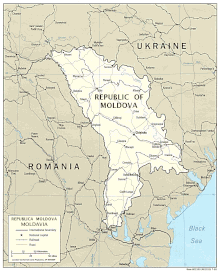Immigration to Romania
Immigration to Romania is less common than immigration to most other EU countries, with Romania having 2.1% of the population foreign born as of 2017 (Eurostat estimates).[1] Of these, 0.9% were born in other EU member states, and 1.2% were born outside the EU.[2] Romania has recently experienced a growing wave of immigration, mostly from the Republic of Moldova, Turkey, Italy, Spain, Southeast Asia, and East Asia [3] and to a lesser extent other parts of the world. In 2013, there were 198,839 immigrants living in Romania, of which 13,000 were refugees.[4] Immigration is expected to increase in the future, as large numbers of Romanian workers leave the country and are being replaced by foreigners.[5][6]

According to DIICOT, Romania has evolved since 1990 from a country of transit for illegal migrants to a country of destination.[7] Within the European Union, the country has the second highest rate of immigration from non-EU countries (86%), just behind Slovenia (90%).[8]
Most immigrants in Romania are from Europe, West Asia, and East Asia, with small but growing communities from South East Asia, South Asia, Africa, Central Asia, North Asia, North America, Latin America, The Caribbean, and Oceania. In Romania there are also refugees from Afghanistan, Sub-Saharan Africa, Middle East, South Asia, Myanmar, and Venezuela.
Republic of Moldova
Over half of the country's foreign-born residents originate from Republic of Moldova. Owing to the former period of union between most of Moldova and Romania, many Moldovans are eligible for Romanian citizenship on the basis of descent. The culture of Moldova is influenced primarily by the Romanian origins of its majority population, being strongly related to classical Romanian culture, and, as such, it is easy for people from neighbouring Moldova to integrate within the contemporary Romanian culture. Many immigrants from the Republic of Moldova prefer to settle in the Romanian counties from the region of Moldavia, because there the culture is more similar to their home country.[9]
EU countries
Immigrants from Italy and Spain often have close relations with Romanians, including intermarriage (see also Romanians in Italy and Romanians in Spain).
Asian and Eastern European workers
In recent years, considerable numbers of Chinese and Vietnamese citizens work in Romania, due to the emigration of a large part of the Romanian workforce.[10] There are also workers from Nepal, Philippine, Thailand, Indonesia, India, Bangladesh, Pakistan, Sri Lanka, Ukraine, Serbia, Lebanon, Turkey, Morocco.[11][12][13][14][15] Many Chinese live in the Ilfov County (the county surrounding Bucharest).
Arabs
Arabs in Romania come primarily from Syria (including refugees of the Syrian Civil War), Lebanon, Iraq and Tunisia. In 2018, most asylum applicants were from Iraq, Syria and Iran.[16]
Africans
Africans come primarily to study in Romania, most of them from the Democratic Republic of Congo, Nigeria and the Republic of Congo. There are also refugees from the Central African Republic, Ethiopia, Mali, Senegal, Somalia, South Sudan and Sudan living in Romania .
Statistics
Estimate immigrants to Romania (as of mid-2017, including refugees):[17]
![]()
![]()
![]()
![]()
![]()
![]()
![]()
![]()
![]()
![]()
![]()
![]()
![]()
![]()
![]()
![]()
![]()
![]()
![]()
![]()
![]()
![]()
![]()
![]()
![]()
![]()
![]()
![]()
![]()
![]()
![]()
![]()
![]()
![]()
![]()
![]()
![]()
See also
- Immigration to Europe
- Demographics of Romania
- List of countries by immigrant population
References
- https://ec.europa.eu/eurostat/statistics-explained/index.php?title=File:Foreign-born_population_by_country_of_birth,_1_January_2017_.png
- https://ec.europa.eu/eurostat/statistics-explained/index.php?title=File:Foreign-born_population_by_country_of_birth,_1_January_2017_.png
- https://adevarul.ro/news/societate/analizA-vin-cei-mai-imigranti-fac-romania-1_5bf516f1df52022f75a9438f/index.html
- "Refugee population by country or territory of origin statistics - countries compared". Nationmaster. Retrieved 2013-10-08.
- "Imigrantii in Romania nu se bucura de drepturile care li s-ar cuveni". Ziare.com. Retrieved 2013-10-08.
- "Le Monde: Romania, noua destinatie a imigrantilor". Ziare.com. 2009-07-13. Retrieved 2013-10-08.
- "Romania, destinatie pentru imigrantii ilegali, afirma seful DIICOT". Ziare.com. Retrieved 2013-10-08.
- "Income Magazine (Former Financiarul.com)" (in Romanian). Financiarul.com. Archived from the original on 2015-11-25. Retrieved 2014-05-09.
- https://adevarul.ro/news/societate/analizA-vin-cei-mai-imigranti-fac-romania-1_5bf516f1df52022f75a9438f/index.html
- https://adevarul.ro/news/societate/analizA-vin-cei-mai-imigranti-fac-romania-1_5bf516f1df52022f75a9438f/index.html
- http://dejulmeu.ro/index.php/2018/08/03/vom-importa-mai-multi-muncitori-din-nepal-filipine-vietnam-si-thailanda/
- https://www.profit.ro/insider/macro/fenomenul-atragerii-personal-tari-exotice-fondul-lipsei-fortei-munca-locala-ia-amploare-romania-aduce-muncitori-filipine-nepal-vietnam-india-indonezia-thailanda-50-ani-importul-fortei-munca-18294111
- https://www.pressalert.ro/2018/03/sarbi-angajati-romania-ce-metoda-au-gasit-companiile-din-banat-pentru-aducerea-cetatenilor-din-tara-vecina/
- http://www.romania-actualitati.ro/muncitori_de_import_din_asia_de_sud_est_vietnam_si_sri_lanka-123937
- https://www.crainou.ro/2018/10/17/muncitori-din-ucraina-vor-termina-lucrarile-la-monumentul-ecvestru-al-lui-stefan-cel-mare/
- https://www.profit.ro/perspective/numarul-persoanelor-care-au-depus-cereri-de-azil-in-romania-in-scadere-19117919
- https://www.migrationpolicy.org/programs/data-hub/charts/immigrant-and-emigrant-populations-country-origin-and-destination
